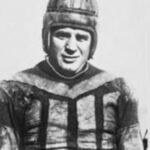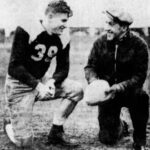It was truly a united front with the involvement of all of the gridiron greats of the era focusing on a single, specific objective. Cardinals’ owner Charles Bidwill was a major influence, as was the legendary Red Grange, along with star players such as NFL MVP Pat Harder, Marshall Goldberg, Elmer Angsman, and Chet Bulger.
All familiar and well-recognized names in the National Football League, and all locking arms to prod, push, and encourage support for a sport that was not even remotely connected to pro football. Although Mr. Bidwill was involved with a variety of sporting activities during his lifetime, this particular sport was perhaps his first love on the athletic horizon.
Aside from his ownership of the Chicago Cardinals, Bidwill had also been an officer with the Chicago Bears, served as the President of the Chicago Stadium Operating Company, owned dog tracks in Florida, and was the secretary of the Chicago Business Men’s Racing Association, which operated the Hawthorne race track. In addition, Bidwill was involved with the National Jockey Club which managed the Sportsman’s Park racing facility, which was adjacent to Hawthorne.
Games Played At Bidwell Stadium
Yet with all of these interests, including his ownership of a printing company and his initial occupation as a lawyer, Bidwill’s likely first sporting love in terms of his personal involvement was his excursion into women’s softball.
Bidwill was the founder of the Chicago Bluebirds professional softball team and was also the co-founder of the National Girls Baseball League (NGBL) which began in 1944 with all teams based in Chicago. Many of the games were played at Charley’s own Bidwill Stadium, located at 1975 East 75th Street on the south side of Chicago.
You may recall the movie “A League of Our Own” which was based on the All-American Girls Professional Baseball League (AAGPBL) that began in 1943, a year before the National Girls Baseball League. Both circuits offered fans the opportunity to view professional athletic competition during the challenging war years.
The founder of the All-American League was Philip K. Wrigley, owner of the Chicago Cubs, and his support of women’s softball was explained in 1973 by David Condon of the Chicago Tribune: “It was during World War II and the Cubs, with so many away at the battlefront, were not a much better team than they’ve been recently.
Mr. Wrigley thought that men’s baseball might be a casualty of war. But each disaster brings opportunity, and Mr. Wrigley saw the chance to open new outfields for women.” Condon went on to describe both Bidwill and Wrigley as “pioneers” for their efforts to provide women with an opportunity to play a professional sport.
Although both leagues initially utilized a 12” ball (similar to today’s fast-pitch softball) and employed the underhand pitching method, Wrigley’s All-American Girls League eventually allowed overhand pitching and began using a smaller ball. While all of the six National League teams were based in Chicago, the All-American consisted of 15 clubs scattered around the Midwest.
The Rockford Peaches dominated the All-American group, claiming four titles during the league’s existence from 1943 through 1954. Bidwill’s Chicago Bluebirds captured the 1946 National crown and added another championship in 1949. Unfortunately, the National League also disappeared after the 1954 campaign.

Softball Games Would Get Crowds Over 5,000
Yet during its brief existence, the National Girls Baseball League proved to be both an interesting and successful product. The Chicago Tribune’s David Condon wrote about the National Girls Baseball League stating: “This was a league that played solely on the Chicago sandlots, and included the Bluebirds and Rock-Ola Music Maids.
They’d get crowds of more than 5,000 many times, and several games were played around the city each night. Bidwill did not insist on calling the sport baseball. It was softball, pure, but so simple. Those gals really could play the game.”
Bidwill was also supportive of 16-inch softball, a sport fairly unique to the Chicago area that is played with endless passion by its followers. No gloves are used by defenders and the pitcher must use a slow, arcing toss to the batter. The ball itself, commonly called the “Clincher” is indeed 16 inches around and hard as a rock at the beginning of each game.
As such, any gathering of current or former players will reveal numerous bent or misshapen fingers, the result of handling the solid ball in the early innings of a game. The Clincher shows no mercy!
While someone new to 16-inch softball might scoff at the probable ease in slugging such a large object, there is a distinct effort by hitters to “place” or “dump” the ball rather than attempt to blast it over the heads of the outfielders. A fly ball can usually be tracked by the outfielders and caught for an out whereas a sophisticated hitter will place the ball where they ain’t! Generally, the fields do not have outfield fences, so the emphasis is placed on moving the runners rather than relying on the long ball.
Charles Bidwill was also a staunch supporter of 16-inch softball and was inducted into the 16-inch Softball Hall of Fame in 2013 which stated: “Charles Bidwill was a 16-inch softball organizer and early supporter of diversity for women and Blacks and led by example. He owned his own stadium that featured two-three games each night. The first game was for his girls—his Bluebirds—then followed by the professional men’s Windy City League. He was also a supporter of a diversity of color.
He organized the best Black team at the time, the Brown Bombers, on a tour of the western states, with Eddie Robinson, Jack Benny’s associate. Many of these players were on the Harlem Globetrotters, including the great first baseman, ‘Sweetwater’ Clifton, one of the first Black athletes to play in the NBA.”

Everyone Knew Charlie Bidwell!
A press release from the Arizona Cardinals in 2013 added: “For the better part of 20 years in the first half of the 20th century, most everyone who played 16-inch softball on the south side of Chicago knew who Charley Bidwill was.
They either played in his stadium or on one of his teams. During a time when America refused to let people participate in societal events based on their gender or the color of their skin, Bidwill opened his softball doors to everyone.”
Although Bidwill passed away in April of 1947, his influence and legacy in the softball universe continued. But where this story becomes even more interesting is how Bidwill managed to utilize his football resources to help support his softball endeavors.
Bidwill tabbed the Cardinals’ creative PR man Eddie McGuire to perform similar responsibilities for the softball side of the business. Everyone in the Chicago media knew McGuire and his bushel full of contacts allowed the Bluebirds, and the league itself, to secure excellent press coverage.
For example, a profile of star outfielder Dolores Benzon of the Cardinals team appeared in the Daily Calumet in 1948 along with a photo of Dolores, her two-year-old daughter Linda, and her husband Del with a reminder that “Girls’ baseball games are played at Bidwill Stadium every Monday, Wednesday, Thursday, and Friday.” McGuire kept the league, and its players, in the spotlight with his non-stop promotional efforts.
Chicago Cardinals Play Radio All-Stars
Another Cardinals’ official, Arch Wolfe, contributed to the management of the Bluebirds and also served as the president of the National Girls Baseball League. In addition, Bidwill encouraged his players on the Chicago Cardinals and other celebrities to support the girls’ softball product. In April of 1947, the legendary halfback Red Grange was appointed as the Commissioner of the National League.
Then in 1948, when the Chicago Cardinals were the defending champions of the National Football League, team members agreed to participate in a charity softball game against the Chicago radio “All-Stars” as reported by the Daily Calumet: “The radio ‘All-Stars’ and the world champion Chicago Cardinals football team are going to combine their efforts to aid many unfortunate youngsters when they meet in a softball game at Bidwill Stadium on July 17.”
While the radio squad would be paced by local luminaries such as Two Ton Baker and Jack Brickhouse, the Cardinals would field a team composed of several of the key Cardinals’ players at the time such as Stan Mauldin, Billy Dewell, Pat Harder, Marshall Goldberg, Vic Schwall, Elmer Angsman, and Chet Bulger. Clearly, the tradition of Charles Bidwill to support charitable organizations was being continued even after his unfortunate passing…and his beloved Chicago Cardinals were a primary reason for that activity.
Bidwell Stadium Sold
Although Bidwill enjoyed the softball championship captured by the Bluebirds in 1946, he was not able to witness the NFL title won by the Chicago Cardinals in 1947. As mentioned, the dueling women’s softball leagues departed in 1954, and Bidwill Stadium was “sold” to the Chicago Park District in early 1950.
I mentioned the word “sold” a bit sarcastically since by this time, the stadium was owned by the Calumet Coal Company. Apparently, the owners were reluctant to sell the facility and the surrounding lands so the Park District simply condemned the land in order to acquire it. Also in 1950, Mrs. Violet Bidwill sold the Bluebirds team to Alvin Tomas, a businessman from the south side of Chicago.
At the same time, the Bluebirds, as well as the remainder of the clubs in the National League, announced that their games would now be played at Gill Stadium at 87th and Greenwood, where all would tackle a 110-game schedule. Bidwill Stadium was later re-named as South Shore Park where softball competition was limited strictly to neighborhood teams.
And so, after 1954, the professional women’s softball leagues disappeared, although their legacies continue to shine through generations of current and future players.
The influence and leadership of Charles Bidwill in the world of professional softball was enormous, with the recognition by the 16-Inch Softball Hall of Fame a wonderful reminder of his stature and willingness to spread the game to any and all who were interested in playing.
Bidwell Viewed 16" Softball As Perfect For Chicago
Though remembered as the architect of the 1947 NFL champion Chicago Cardinals, Charlie Bidwill’s granddaughter Nicole recalled his leadership in terms of promoting softball participation no matter the gender or color of the player might be.
Nicole stated: “For those reasons, one of the sports in which he also had a great affinity was 16-inch softball. My grandfather was very, very proud to be from Chicago. I know he viewed 16-inch softball to be a perfect match for the city and its small, close-knit neighborhoods.”
We hope you enjoyed our brief excursion today into the wide world of sports of Charles Bidwill, where his efforts to promote a little-known sport at the time will be as well-remembered as were his enormous contributions to the history of the National Football League.
Thank you for joining us for this episode of “When Football Was Football,” here on the Sports History Network.
Author and Host - Joe Ziemba
Joe Ziemba is the host of this show, and he is an author of early football history in the city of Chicago. Here, you can learn more about Joe and When Football Was Football, including all of the episodes of the podcast.

Please Note – As an Amazon Associate I earn from qualifying purchases
Resources
More From When Football Was Football
Paddy Driscoll’s Almost Perfect Season
Back at the beginning of the National Football League in...
Read More120,000 Fans Witness High School Football Game in 1937!!!
Let’s set the stage… It was a warm November afternoon...
Read MoreIn The Beginning: An Interview With Joseph T. Sternaman
And, you may ask, who is Joseph T. Sternaman? Sternaman...
Read More1948: The Last Hurrah of the Chicago Cardinals
Cardinals’ fans are familiar with the long, sad story concerning...
Read More


